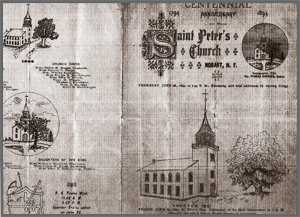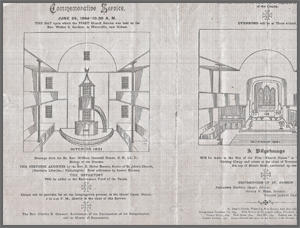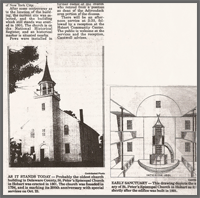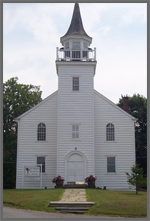| Back to Historical Articles |
St. Peter’s Episcopal Church
 In 1794, the Rev. Walter Clark Gardner, rector of the church in Hudson, took a vacation trip through the Catskills and stopped in what was then known as Watertown, now Hobart. Here on the evening of St. Peter’s Day, June 29, “finding a number of earnest church people, I was persuaded to give a church service at the house of Stephen Barlow, after supper and before sunset. This was the first church service held in their midst,” he wrote. He added, “The people seemed much in earnest and after the service I baptized two children. Next day I spent advising many who were eager to found a congregation and build a house of God.”
In 1794, the Rev. Walter Clark Gardner, rector of the church in Hudson, took a vacation trip through the Catskills and stopped in what was then known as Watertown, now Hobart. Here on the evening of St. Peter’s Day, June 29, “finding a number of earnest church people, I was persuaded to give a church service at the house of Stephen Barlow, after supper and before sunset. This was the first church service held in their midst,” he wrote. He added, “The people seemed much in earnest and after the service I baptized two children. Next day I spent advising many who were eager to found a congregation and build a house of God.”
On December 8, 1794 the first trustees were elected for the incorporation of the parish of the “Episcopal Church of St. Peter’s in the Townships of Stamford, Harpersfield and Kortright.” The first trustees were Augustus Bales, Gershom Hanford, Elijah Baldwin, Ebenezer Sturges, Henry Bradford, Truman Beers, Andrew Beers, Stephen Barlow and Moses Sackrider.

At a meeting of the trustees on July 13, 1795, plans were first made for a church building. They voted to construct a church “50 feet by 40 feet.” In January of 1797, even before beginning work on the church, the wardens and vestry appointed a committee to consider building a rectory. During this time of planning, meetings were held in what was known as the “Glebe House,” located in what is now Locust Hill Cemetery.
St. Peter’s parish was admitted to union with the diocese of New York on October 12, 1796, the Rev. W. C. Gardner being rector.
Subsequently there was much controversy over the location of the building and not until June 1801 was the church located on Beer’s Pine Hill, now known as Church Hill. Work on the building was begun and the frame was raised July 4 of that year. The edifice was so near completion by December 17 that a meeting was held there for the election of a rector, and the first church service was held on Christmas Day.
 St. Peter’s Parish was admitted to union with the diocese of New York on October 12, 1796, with the Rev. Mr. Gardner being the rector.
St. Peter’s Parish was admitted to union with the diocese of New York on October 12, 1796, with the Rev. Mr. Gardner being the rector.
A rectory (no longer existing) was built at the same time. Apparently at least some funds for these buildings were donated by Trinity Parish in New York City. This was a church which supported a large missionary program and provided funds, as well as actual plans and specifications, for many Episcopal churches across the state.
Consecration of the church was not done until 1819, however, when Bishop John Henry Hobart, Bishop of the Diocese of New York, for whom the village was named, conducted the service.
In June, 1802 the church was ordered painted, pews were installed by 1822, a stove in 1829, and a bell in 1830. The latter was replaced in 1855. An early organ which was built in the village was also replaced with the current instrument in 1855.
A building program during 1873-1880 included the addition of a chancel, vestry and organ room, and some  redecoration of the interior. The latter included some reconfiguration of the pews, graining of all wood, and the installation of stained glass and new light fixtures. Central heating was installed in 1901. The church still lacks plumbing.
redecoration of the interior. The latter included some reconfiguration of the pews, graining of all wood, and the installation of stained glass and new light fixtures. Central heating was installed in 1901. The church still lacks plumbing.
The church occupies a commanding site atop Pine Hill, a small circular knoll that is the highest point in the village. The parcel originally included 10.5 acres, including both Pine Hill, and Locust Hill, now the site of the village cemetery. A small cemetery adjacent to the church seems to be the final resting place of many of the early deacons or vestry members. Since more than half of the approximately 30 markers carry the name Foote, this may originally have been a family cemetery which was also used by the church at that time. Burials date between 1817 and 1880.
Much of the original property has since been subdivided and these sites now are occupied by private homes. However, in its early days it included not only the church, rectory, and cemetery, but also a carriage house.
Built in the Federal and Greek Revival style, the church features a square tower surmounted by an octagonal, louvered belfry with steeple. The first floor windows are glazed with stained glass that replaced the originals in 1873. The second-story windows which light the gallery feature multi-pane colored glass with foliate designs.  These appear much older, and may date to the 1820’s or ‘30’s. In addition, the rear wall features a three-part arched stained-glass memorial window.
These appear much older, and may date to the 1820’s or ‘30’s. In addition, the rear wall features a three-part arched stained-glass memorial window.
An early drawing shows the old “three-decker,” consisting of Communion table, reading desk and pulpit; the latter reached by a winding stairway. The present altar was installed about 1872 and in 1890 a chancel was added and memorial windows placed in the edifice.
The stone entrance step and large bluestone entry landing stone bear a carving which identifies it as a gift of the Sunday School class of 1901.
The church was nominated to the State and National Register of Historic Places in 1997.
| CLERGY SERVING ST. PETER’S | |
| *Ebenezer Dibblee, D.D. | 1794 |
| *Walter C. Gardner | 1796-97 |
| Robert G. Wetmore | 1798 |
| Philander Chase | 1799 |
| Joseph Perry | 1802-09 |
| *Joseph Prentice | 1809-1811 |
| Andrew Thompson | 1815-1817 |
| David Huntington | 1818-1820 |
| Charles E. Hamilton | 1820-1821 |
| J. Peter Fisher Clark | 1821-1822 |
| Beardsley Northrupp | 1826-1828 |
| *Hewlett R. Peters | 1829 |
| J. M.Tappan | 1830-1832 |
| William Allison | 1832-1833 |
| David Huntington | 1834-1838 |
| Sturges Gilbert | 1839-1841 |
| A. H. Cornish | 1841-1843 |
| Sheldon Davis | 1843-1848 |
| William A. Curtis | 1849-1862 |
| Stephen P. Simpson | 1863-1865 |
| A. Sidney Dealey | 1866-1867 |
| John Boyle | 1867-1868 |
| D. Ellis Willes | 1869-1872 |
| Arthur Wittaker | 1872-1874 |
| F. D. Joudon | 1876-1877 |
| Benjamin T. Hill | 1878-1879 |
| Reginald E. Barnes | 1879-1886 |
| John A. Farrar | 1887-1890 |
| Eugene Griggs | 1890-1892 |
| Thomas Burrows | 1893-1896 |
| S. H. Meade, M. D. | 1896-1897 |
| Benjamin T. Trego | 1897-1902 |
| John W. Foster | 1903-1904 |
| H. Landon Rice | 1904 |
| Robert N. Turner | 1905-1907 |
| Herbert E. Martin | 1908-1910 |
| Alexander Elliott | 1910-1912 |
| Willet N. Hawkins | 1912-1927 |
| Harold H. R. Thomson | 1928-1929 |
| Dever L. Shelmandine | 1930-1931 |
| John C. Duncan | 1931-1934 |
| Clarence W. Jones | 1934-1936 |
| Jackson A. Martin | 1936 |
| During the interim between Jackson Martin and Delos Wampler, the pulpit was filled by supply priests and lay readers. |
|
| D. Delos Wampler | 1953-1959 |
| Walter A. Perkins (Canon) | 1959-1961 |
| Duncan Fraser | 1961 (3 mos.) |
| Robert E. Clark | 1961-1962 |
| John Eastman | 1962-1963 |
| James D. Swearingen | 1963-1965 |
| W. L. Shetler (Lay Leader) | 1965 |
| John Mills | 1965-1970 |
| David Jenkins | 1970-1983 |
| Edward F. Caldwell | 1983-1984 |
| Dale Craig | 1985-1992 |
| Richard Frye | 1993-1995 |
| Rodney Whiting | 1995-1997 |
| Paul Hartt | 1999-2003 |
| David Collum | 2003-2008 |
| Nancy Truscott (Deacon) | 2004-2008 |
Note: The above article was written using information found in pamphlets and articles from the Stamford Mirror Recorder, the Walton Reporter, and other local newspapers provided by Barbara (“Bobbie”) Simmons.
